By Art Merrill
Some of the fun in collecting historical arms is that we’re sometimes confronted with interesting puzzles that appear to contradict what we think we know. Take our example here: a beautiful, supposedly original Springfield M1903 Mark I rifle that just doesn’t look right. Having no taste for eating crow, I learned a long time ago to never say about rifles, “They never made one like that.” Still, the more I examined the breathtakingly pristine rifle, the more I believed that this one, indeed, was never made.


Which of these two Springfields is the fake?
Buried Treasure
The Mark I was a consignment item on the rack of a local gun shop. Its most remarkable feature was its pristine condition, and so the first natural thought was that it must be one of those recent rebuilds being turned out by several makers today to satisfy demand created by Vintage Military Rifle competitions. This one, however, was a Mark I model. What makes the Mark I immediately and obviously different from other M1903s is the cut in the left receiver wall, an ejection port to accommodate the use of the Pederson device (see sidebar). While it is perhaps not unheard-of to rebuild a Mark I for shooting competitions, it certainly seems unusual. But the $2,000 price tag on this baby was more than twice the going price for M1903 rebuilds or typical Mark I’s. Odd.
According to the gun shop owner, the consigned rifle’s owner claimed the rifle to be an absolute original that Springfield Armory had placed in a safe immediately after manufacture to be kept as an unissued, pristine example of the Mark I. That would account for the unblemished metal finish and unmarred stock, and it makes a great buried treasure story, but let’s separate fact—the rifle we see before us—from statements.
Memory, like hope, is a terrible thing to rely upon. What memory served at that moment in the store was that Springfield Armory had turned out something like 100,000 Mark I rifles for the Pederson device up until around 1920; while not especially “rare” or “scarce,” they certainly qualify as “not entirely common.” A bona fide original in like-new, unissued condition might easily be worth two grand to a collector. The barrel date of 1920 seemed right, the receiver markings were right, but pulling the bolt showed the trigger/sear to be standard M1903. And the magazine cutoff and spindle were standard, too. I flipped the rifle over and over again, looking at the details. Was Springfield Armory “Parkerizing” metal in 1920? Is it the right color?
My attention kept going back to the stock; it looked exactly like the stocks on commercially rebuilt M1903A3 and M1903A4 rifles: too nice an oil finish on too nice walnut with too much figure for genuine GI issue wood. What else? Um … No cartouches or stampings of any kind. Not even a “circle P” on the pistol grip to denote proof testing. Other than the condition, what’s not right with the stock? Well, it only has one reinforcing bolt. Don’t all of my Springfields have two? But there’s something else—what is it? Hmm … Time for some research.
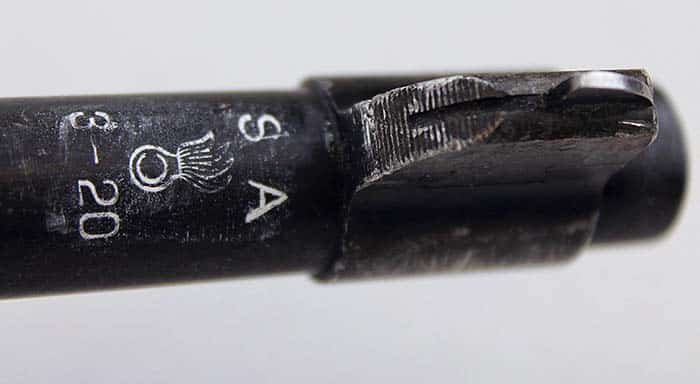
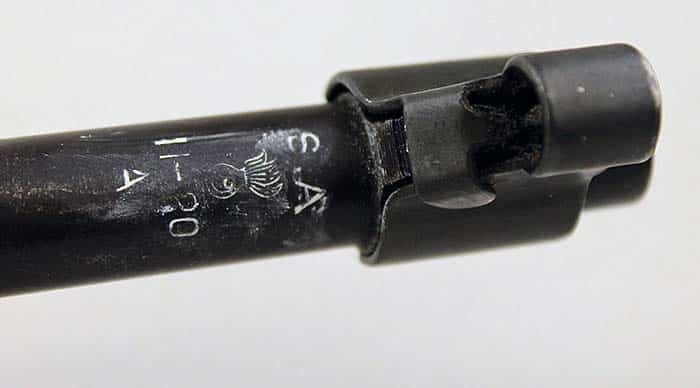
By the Numbers
Springfield Armory did not set aside a block of serial numbers for Mark I production; Mark I serial numbers are mixed in with standard production M1903s, the first/lowest being 1,034,502 and the last/highest 1,197,8342. The serial number of our Mark I—1,066,64XX—falls within that range and, according to Springfield Armory records, was made in 1920. So far, so good.
Springfield Armory began applying an iron phosphate “Parkerized” finish in late 1918, followed by dipping the metal parts in oil containing a black dye to give them a dark, non-glare finish. Still OK.
The barrel date, 11-20, however, is iffy. Manufacture dates on Springfield rifle barrels are marked as month-year. According to Brophy, “the latest date observed of what appeared to be an original Mark I rifle barrel has been 5-20.” Mark I barrel dates later into 1920 are apparently unconfirmed by records, and Brophy’s use of passive voice fails to tell us the source of his information. Still, it’s conceivable that this Mark I’s 11-20 dated barrel and receiver may be original mates because assembly of Mark I’s apparently continued into June 1921.


Stock Strikes Out
But the rifle’s stock is the deal killer. Not only does it absolutely disprove the seller’s claim that the rifle was immediately stored as-is upon manufacture, we can also be confident it is not even an original military issue stock. Springfield Armory records show 101,775 Mark I’s made from July 1919 to June 1921; adding the unknown exact number made from December 1918 to July 1919 brings the speculated total to about 145,0002. So, these were not just a handful of experimental rifles quickly bolted to uninspected stocks—Mark I’s were general issue rifles intended for frontline troops that went through the usual armory inspections, and stocks originally bore the usual inspector’s marks.
Springfield Armory stamped their stocks with letters or numbers inside a circle, oval or other shape in front of the trigger guard plate. Also, there should be a “circle P” on the pistol grip and an armory inspector cartouche on the left side. The consignment rifle stock has no visible markings at all. Possible strike one.
Regarding the lone rear stock reinforcing bolt on our Mark I, the Army standardized the addition of front reinforcing bolts on all Springfield stocks beginning in 1917. The consignment rifle, supposedly made three years later, lacks this front stock reinforcing bolt. Possible strike two.
Original stocks for Mark I’s had a portion of the stock relieved to clear the Pederson device ejection port on the receiver. The complex stepped shape of the stock relief on our Mark I does not match that described, diagramed and photographed anywhere. Possible strike three.
But handling the rifle in the gun shop, what was immediately wrong with it was so obvious that I looked right past it. Did you ever walk around the house looking for the keys in your pocket or the sunglasses on top of your head? It was like that.
Springfield Armory issued Mark I’s with Type 2F “S” or “Scant” stocks; the consignment Mark I has a later (1942) Type 8 M1903A3 Remington full pistol grip stock that didn’t exist in 1920. The owner claimed the rifle was stored right after it was manufactured; the Type 8 stock makes that claim patently impossible.
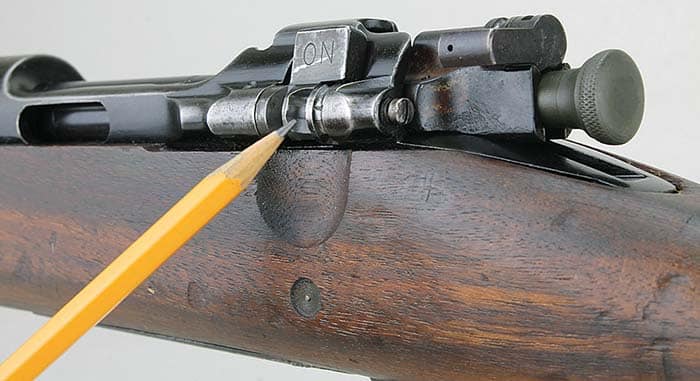
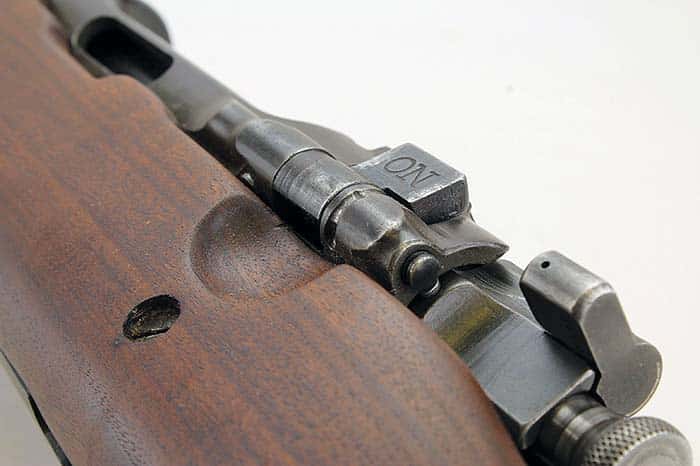
An Armory Rebuild?
OK, discounting the owner’s story, is it possible the rifle got a Type 8 stock as part of an armory rebuild? It could also have received a non-Mark I sear, cutoff and spindle at the same time. When M1903 and M1903A3 rifles went back to armories for refurbishment, because nearly all parts are interchangeable, there was little thought to keeping original parts with their parent rifles. It’s common to see, for example, machined parts from early M1903 rifles on later M1903A3 rifles that originally had stamped parts and vice-versa.
Remington cut Type 8 stock inletting to fit both M1903 and M1903A3 rifles, and it’s a reasonable bet that some Mark I’s came out of arsenal rebuild with a Type 8 stock. Maybe, but not this stock, because it has finger grooves. Cutting finger grooves into new stocks apparently ceased the same year the Type 8 became issue, and I found no photos, drawings or descriptions of genuine GI issue Type 8 stocks wearing finger grooves.
The last bit of damning evidence is the portion of stock relieved to clear the Pederson device ejection port. When armories refurbished rifles, they had no reason to expend the time or effort to relieve Type 8 stocks to accommodate the Pederson device ejection port, as the Army never issued the Pederson device and destroyed all but a few in 1931, a full 11 years before the Type 8 stock existed. So, even if our Mark I might have received a Type 8 stock during armory rework, a genuine Type 8 stock does not have the ejection port relief. Coupled with the finger grooves and total absence of any visible markings, this Type 8 stock is clearly not original.
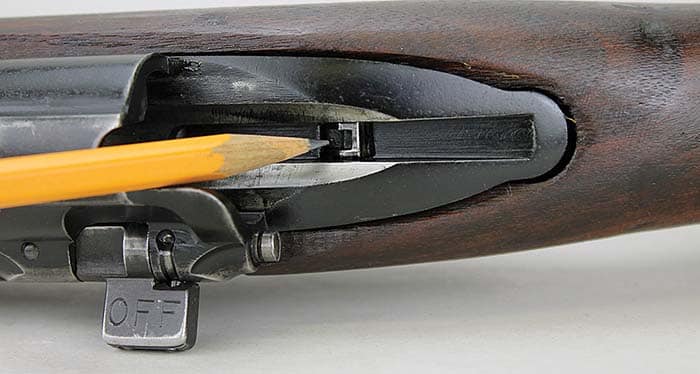
Baloney
Conclusion: The consignment Mark I Springfield is a fake. Because someone cut the ejection port relief on the aftermarket stock when none was necessary and because of its overinflated price, it’s apparently a deliberate fake. However, there’s no way we can know the intent of the person who built it or the knowledge of the seller, so accusations are pointless.
Still, I wanted to check the stock’s barrel channel for any markings and to see if the barrel-to-receiver witness marks perhaps definitively show the barrel to be a replacement.
“Hey, would it be OK if I pulled the stock off that consignment Mark I Springfield to take a look inside?” I asked the gun shop owner a week or so after he allowed me to photograph it.
“Too late,” he said, “someone bought it off the rack. Why, what’s up?”
“Oh. Well, it doesn’t matter now,” I said. “I just wanted to check it out.”
Should I have told him and suggested he contact the buyer and the seller with my suspicions? My first impulse was to do so, but no one asked my opinion. Capitalism—and especially vintage firearm capitalism—is a caveat emptor world, and the buyer could have and should have done his own research. In the end, perhaps what matters is that everyone is happy, even if they are believing a fiction.
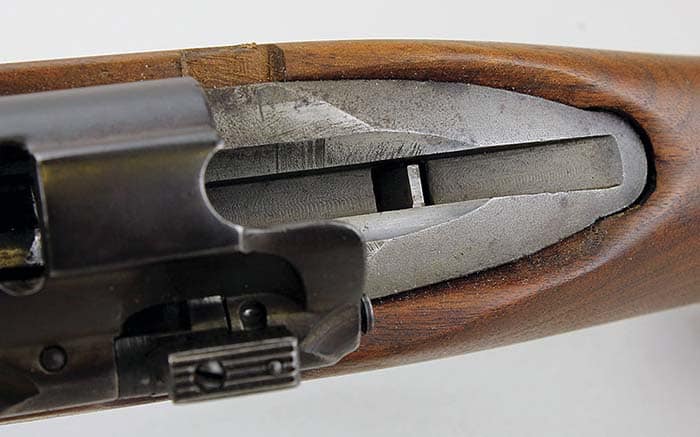
Happy is good. And who doesn’t enjoy a buried treasure story?
Some final notes: The genuine Mark I photographed here is in my collection. In comparing it to the suspect Mark I, I found more discrepancies in other details, but here I wanted to show you how to immediately ID a correct Mark I while standing on a gun shop or gun show floor.
They say it is the morsel of truth that lends believability to the best fiction. Sadly, if not deliberately altered, that suspect Mark I would have been valuable, because the barrel date alone would add to the base of knowledge about Mark I manufacture dates. If the barrel and receiver are original mates, then that is the morsel of truth in this Mark I’s fiction.
Which is the fake?
The rifle on top is the fake. This suspect Mark I stock is the Type 8 pistol grip stock, first used in 1942, more than two decades after Mark I production ceased. Note that it lacks the proper second stock reinforcing bolt standard on issue Springfields since 1917.
The genuine Springfield sports a correct Type 2F “Scant” stock (named for its scant pistol grip) on a Mark I.
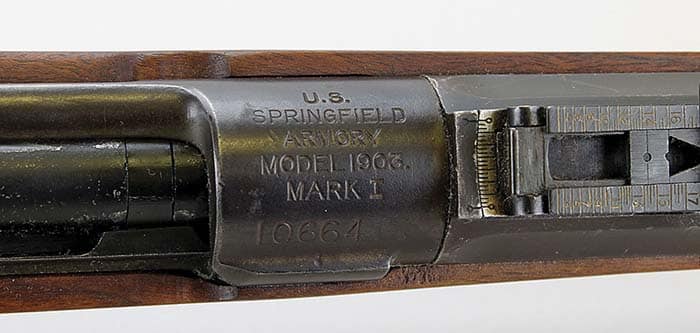
The Secret Springfield
In the summer of 1945, an Army intelligence unit logged an interesting footnote in the history of—oftentimes futile—military secrecy, when it discovered a complete M1903 Mark I rifle with a Pederson device in the reference collection of Rheinische Westfallian Sprengstoff in Nuremberg, Germany. It had been in the collection since 1920.
The Pederson device transformed the M1903 Springfield bolt action into a genuine semiautomatic rifle by replacing the bolt with the “U.S. Caliber .30 Automatic Pistol Model of 1918 – Mark I.” A Mark II version was for use in the M1917 (“Enfield”) rifle. Invented by John Pederson at the Remington Arms Company during WW I and first demonstrated to the U.S. Army on October 8, 1917, the U.S. War Department treated it with extreme secrecy and intended to issue it to troops fighting in Europe. An order for 100,000 devices, a million magazines and 800 million rounds of ammunition quickly followed.
Though it worked very well indeed, the Pederson device utilized a pistol cartridge—hence the moniker, “Mark I Pistol”—with about one-tenth the power of the Springfield’s .30-06 cartridge. The Army wanted the device in the hands of troops assaulting enemy trenches, its overwhelming rate of semiautomatic fire—and surprise, the reason for secrecy—being the primary advantage negating concerns about lesser bullet energy when fighting would be at close range. By October of 1918, the Army had ordered 133,450 Mark I and 500,000 Mark II Pistols and 9,686,000 magazines, but the end of the war the following month reduced or suspended orders. The Pederson device never saw combat. In the end, the Army only received 65,000 Mark I Pistols, 1.6 million magazines and 65 million cartridges. On November 4, 1919, 101,775 M1903 Mark I rifles and 65,000 Pederson devices went into storage. In March 1931 the War Department declared the device no longer secret and offered it to the Navy and Marine Corps, who both declined. The next month the government destroyed 64,873 Pederson devices and 60 million rounds of ammunition.
-Information from the Remington Arms Company report prepared by J.D. Pederson and published in The Springfield 1903 Rifles by Lt. Col. William S. Brophy, USAR, Ret.
| This article first appeared in Small Arms Review V22N2 (February 2018) |












